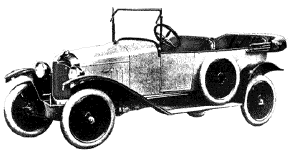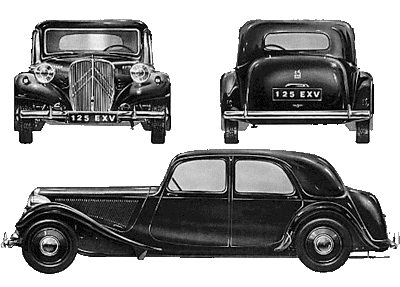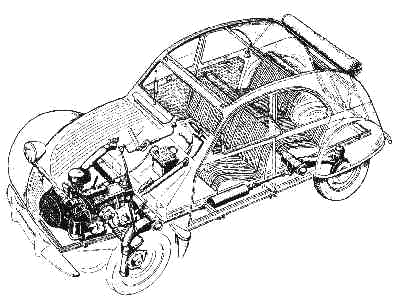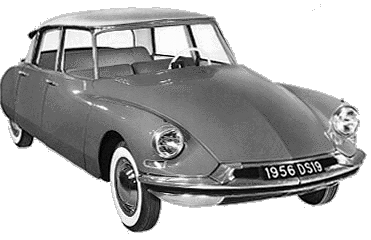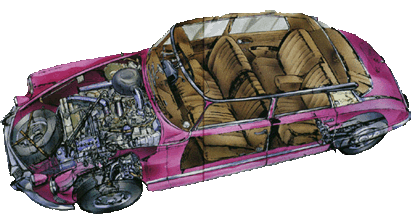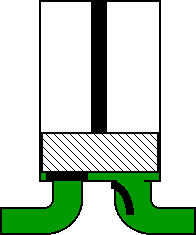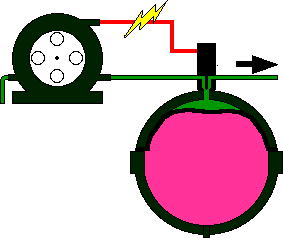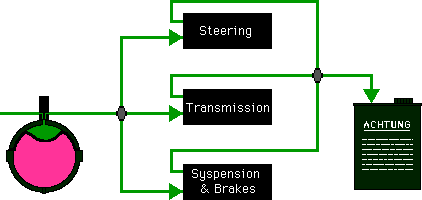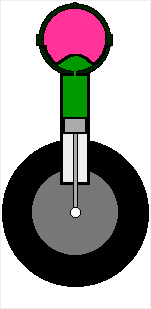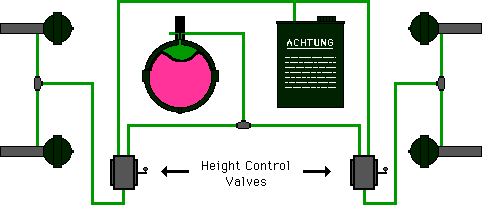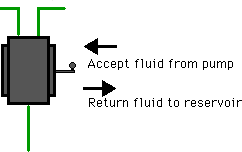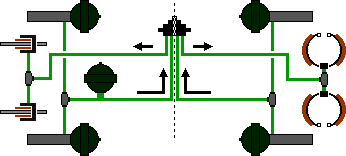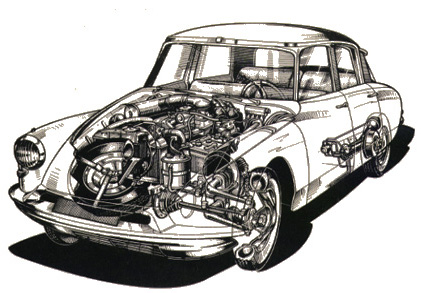
|
Citroën decided that this was an inefficient way of making cars, and it placed too much burden on the consumer. The Type A was designed to be a complete vehicle. The engine, drivetrain, chassis, and body and interior were all designed to be manufactured and assembled at the factory. When a consumer bought a Citroën, he was delivered a complete vehicle. This was very advanced thinking for the day, and it was not long before all automobile manufacturers operated in this paradigm. |
The Type-A
In the early 1930's when it came time to replace the Type A with a more modern design, André Citroën investigated all the automotive innovations with which leading-edge designers were experimenting. Citroën was friends with an American engineer named Edward Budd, who had made the first vehicles whose design eschewed any wooden materials and were constructed entirely of metal. Budd had a concept for doing away with the chassis and making vehicles completely of sheet metal body "shells." American manufacturers were not adventurous enough to attempt implementing such a radical design, but Citroën was intrigued. From the start, he designed his new model to be based on this experimental method. Citroën also solidly embraced the concept of front wheel drive as a more logical and practical means of propelling an automobile. The newly innovated constant velocity joints made this possible. Citroën devised an all-new configuration whereby the transmission would be mounted in front of the engine block, with half-shafts extending out to the front drive wheels. This consolidated the entire drivetrain at the front of the vehicle, and eliminated the need for a drive shaft extending aft, as well as the heavy and cumbersome rear differential. This also allowed the car to be designed with unparalleled interior space relative to the exterior dimensions. In addition to this, Citroën recognized the torsion bar as a more space-efficient alternative to the coil or leaf spring. He also felt that it gave the vehicle a better ride and more responsive handling. He decided to use torsion bars on both the front and rear suspension. Cars of the day routinely had independent front suspension, but the rear differential was always implemented as a rigid unit. Having avoided this pitfall, Citroën was able to make his rear suspension independent as well. The final design incorporated four-wheel independent torsion bar suspension. |
The Traction Avant
By 1934 André Citroën had the vehicle in production. He called it the "Traction Avant," which literally translates to "drive up-front." Visually it did not look unlike other "old-timers" of the era, with the big fenders and bulbous headlights (although it had somewhat of a lower profile due to the front wheel drive), but the driving experience was unlike anything else on the road at the time. All the innovations that Citroën incorporated came together perfectly and created a truly remarkable unit. The front-wheel drive and fully independent torsion bar suspension gave the Traction Avant better roadability than anything manufactured before. In many ways, the Traction Avant was the first truly "modern" car. Some consider it to be the DC3 of automobiles. It was the first car in the world to be mass-produced without a chassis, and now unibody design has taken over the entire marketplace. Today it is extremely rare that a car would be built with a chassis (some low-volume sports cars still employ the design). Front-wheel drive took a little longer to catch on, but today almost every model of car being built incorporates it. Fully independent suspension is often reserved for performance-oriented vehicles, but is recognized as a superior design. It was present in virtually every Citroën designed hence. The Traction Avant was an instant success, and it catapulted Citroën into a prominent position in the global automobile market. The model was somewhat upscale, however, and after WWII Citroën set out to design a car that was more accessible. In typical style, greatest emphasis was placed on incorporating innovation. |
The 2CV
Today it is commonplace for automobile designers to target specific markets, but at this time manufacturers generally produced whatever kind of car they'd always been producing. Citroën intended this new car to be useful to the "masses," and the designers began by thinking about what the masses' specific transportation needs were. They needed to get from place to place, but reliability and ease of repair was much more important than speed. The masses generally lived in the countryside where terrain was rough. It was as important to be able to traverse a deeply rutted field as it was significant distances. The masses also needed to bring things with them from place to place, often things that were much too large or cumbersome to be easily transported in small cars. Finally, the masses didn't have a lot of money to invest into the purchase and maintenance of vehicles. The designers summed these goals in a semi-metaphoric example: the car should be capable of carrying a basket of eggs across a plowed field without any breaking. Their solution was the 2CV. It was introduced in 1948, and is one of the most utterly simple automobiles ever constructed. It is also one of the most entirely useful. Like the Traction Avant, it incorporated unibody construction and front wheel drive. It had a 375cc, 9bhp, air-cooled, 2-cylinder engine that was mounted in front of a 3-speed gearbox. Half-shafts came out each side to drive the front wheels. The suspension was also fully independent. It was incredibly simple, but also ingenious. There were leading arms in front and trailing arms in the rear. One long tube spring ran along the rocker panel on either side. The front and rear swinging arms on that side were attached to either end of the spring. In this way, front and rear suspensions on each side worked against each other like the opposing sides of an arch, with the horizontal tube spring as the keystone. The configuration made for a very stable ride. The swinging arms on the light, boxy body allowed a tremendous amount of movement, and it was indeed possible to drive the car smoothly across a plowed field. The entire top of the 2CV was made of durable fabric which could be rolled back to entirely open up the passenger compartment. In this way, long and cumbersome objects could still be transported in the small vehicle. It was this feature that gave the car the nickname, "The Sardine Can." |
The Goddess
The 2CV was another smashing success, and Citroën advanced its position in the global automobile market. But by the early 1950's the Traction Avant was becoming outdated. It was time for a modern replacement. In true Citroën fashion, it was to be unlike any other car ever created. The car was to embody the word, "innovation." They set out to create the most sophisticated automobile the world had ever seen. The designers utilized a conventional, in-line 2-liter 4-cylinder engine. All other conventional knowledge about automobile construction was thrown out the window. They decided that there would be one master hydraulic system that would operate all major subsystems of the car. It would be powered by a high-pressure pump, and distributed where needed. The brakes, the power assisted steering, the semi-automatic transmission, and even the suspension supports would all be powered by this master hydraulic system (see below for more detailed info on how this hydraulic system works). Great attention was also placed in the appearance of the car. It was intended to be aerodynamic, and this gave it a natural sleek appearance. But it also incorporated some principles of Art Deco, which was popular in France at the time. Beyond sleek, the lines coalesced to form arguably the most pleasing automotive shape ever created. Everything about it, from the broad, sloped snout to the trim, minimalized rear, suggested graceful forward motion. The layout was principally what Chrysler would decades later come to call "cab forward." The wheels were moved out to the corners. All major engine and drivetrain components were under the hood (although the ass-backwards engine did protrude into the passenger compartment a bit). Without a driveshaft, the floors were kept entirely flat straight across in both the front and the rear. The muffler was in the space under the front seats, and the gas tank was under the rear seats, giving the belly pan a very smooth profile. The independent rear suspension left space for a very deep and surprisingly spacious trunk for what from the outside appeared to be a very petite rear end. The most striking aspect of the car was the hydraulic suspension. It was called "hydro-pneumatic." Rather than springs or torsion bars, it used compressed nitrogen in conjunction with high-pressure hydraulic fluid to to suspend the weight of the vehicle. This provided a hitherto unheard of balance between a smooth ride and nimble handling. Unlike the big American land yachts, the hydro-pneumatic suspension would react quickly to the road, like a skiers legs reacting to the irregular surface of the ski slope. And it also made it possible to implement a self-leveling feature, so even with a heavy load the car always rode at the same height. A control lever under the dashboard adjusted the mechanisms that accomplished the leveling, making it possible to actually change the ride height of the suspension. On the lowest level the car would settle practically to the ground. On the highest level it would be as if on jack stands. There were three driving height settings in between. The car would have a tendency to settle to the ground when the engine was not running (the better condition of the system the slower this settling process would be). When the car was started up, the suspension would pressure up, and the car would come up to standard riding height. This could be somewhat disconcerting to first-time passengers. Citroen also introduced the "semi-automatic" transmission. The clutch and gear change were also controlled by the master hydraulic system. There was no clutch pedal on the floor. Accelerating the engine would cause the clutch to engage. There was a dainty little lever on the top of the steering column that would effect gear change. Letting up on the gas as is done for conventional gear changes would cause the clutch to disengage, and moving the lever would cause the gears to change. Stepping on the gas would again engage the clutch. Watching the car's inertia it was clear that it was operating in the manual transmission paradigm, but the driver could go through the gears without his hands ever leaving the wheel.
What was most amazing about this car is that all this was done with 1955 technology. All the mechanical, electrical, and hydraulic systems were typical of the day. This was just the first time that they'd been brought together in this application. Some parts of the hydraulic system have tolerance as small a 1 micrometer (for example the moving part of the hight corrrector)! The true miracle was that the engineers were able to mass produce them with 1955 production techniques, and that complex as they were, they were competitively priced with other luxury touring sedans. The car was called the DS19. It was an instant success, and was quickly deemed "The Goddess" (the letters "DS" in french are pronounced homonymously with the French word for "Goddess"). It underwent modifications about halfway through its lifecycle, chaning from black hydraulic fluid to green, and increasing the engine size to 2.1 liters. The new model was known as the DS21, but the basic concept remained essentially unchanged until production ceased 20 years later. It's successor, the CX, is more modernized with respect to appearance, integration, and fit and finish, but the underlying layout and principle systems are essentially the same as with the DS series. The Traction Avant and the DS series were two landmark designs in the history of the automobile. But while other manufacturers were quick to adopt the innovations of the Traction Avant, the complicated systems used in the DS series have not caught on. Many detractors use this as their principle criticism of the design. In recent years, however, some examples of the use of these innovations have begun to appear. Certain luxury car makers have experimented with self-leveling systems on the rear suspension. The high-tech "fully active suspensions" on today's most sophisticated performance cars build upon the original hydraulic systems of the Citroën. American luxury car makers are now making brake, power steering, and automatic transmissions operate as subsystems off one main hydraulic system instead of having individual isolated systems each with its own reservoir and type of fluid. The Traction Avant was years ahead of its time. The DS series was so far ahead of its time that now, over 40 years later, time is just starting to show hints of catching up. |
About Citroën HydraulicsThe principles of hydraulics have been present in automotive design since the first brake system distributed pressure to each wheel by means of compressing fluid rather than pulling cables or mechanical linkages. Hydraulic systems were further used in similar ways such as operating clutch mechanisms, and in new ways such as hydraulically dampened shock absorbers, power assisted steering, and automatic transmissions. The designers of the Citroën DS19 set out to use hydraulics in an all new way. Rather than have a number of independent hydraulic systems, each with its own fluid type, reservoir and pumping mechanism, the DS19 would have one master hydraulic system that would feed a universal fluid to specialized subsystems. This would simplify the design and create a more unified automobile. The master hydraulic system was kept at a constant pressure, fed by a pump that was powered by the engine itself by means of a belt (the way a conventional power steering unit is powered). Hydraulic pressure was distributed to the various subsystems as needed, and would always return to a common reservoir. The considerable amount of pressure that the engine was capable of generating gave the DS19 designers considerable creative latitude. They decided that not only would the hydraulic system dampen the suspension, but it would actually suspend the vehicle as well. Rather than employing springs or torsion bars, the designers of the DS19 made the hydraulic shocks "load-bearing." This would provide an incredibly smooth ride, and would allow certain functionality that would be impossible with conventional suspension methods. By regulating the volume of fluid distributed to the load-bearing shocks, it was possible to adjust the height at which the vehicle was suspended. By using the position of the suspension arms relative to the body as the regulating devise, it was possible for the vehicle to automatically level itself when exposed to an uneven load. By simply providing a control mechanism that effected an adjustment of the height regulation device, the overall riding height of the vehicle could be set to various levels. The designers of the DS19 redefined the automotive hydraulic paradigm. Beyond changing the way that the hydraulic systems were implemented, they came up with entirely new ways of using hydraulics, and were able to do things that had never been done before.
The High-Pressure PumpThe genesis of the hydraulic system is the reservoir. It must be large enough not only to contain the combined reservoirs of a conventional vehicle, but also all the fluid required to bring the suspension up to full height. It is located at front of the vehicle to the right and behind the spare tire.
At the heart of the pump is a simple piston. When the piston ascends, a valve opens to allow fluid to be drawn from the reservoir. When the piston descends, that valve closes and another opens allowing fluid to be forced out under pressure. Through the magic of hydraulic physics, this simple mechanism, smaller than a roll of dimes, is able to generate enough hydraulic pressure to hold the body aloft even under stress and heavy loads.
In order to generate an uninterrupted flow of pressurized fluid, the pump unit is actually comprised of seven pistons arranged in a circle. By rotating an armature, each piston is depressed in succession and a constant supply of fluid is produced. The armature is turned by a pulley that is run by a belt, and can be engaged or disengaged by means of an electro-magnet clutch.
Pressurized SpheresA fundamental component of the Citroën hydraulic system is the pressurized sphere. There are six such units in the average DS19. They are used for a variety of purposes, but each one functions in exactly the same way. Each unit separates into halves. They screw together to form a solid unit that has a perfectly spherical cavity inside. A hemispherical rubber bladder conforms to one half of the cavity, secured in the seam between the two halves. The cavity is then completely charged with compressed nitrogen creating a very stable pressurized environment. (Note: more modern sphere units to not unscrew into halves, but were maufactured as integrated units) Hydraulic fluid can enter the unit through an orifice below the bladder. As a quantity of fluid is pressed into the cavity, the rubber bladder is forced upward further compressing the nitrogen gas. When pressure outside the unit decreases, the quantity of fluid will be forced back out of the cavity as the compressed nitrogen again attains equilibrium.
The Main AccumulatorThe first use of a pressurized sphere is as the main accumulator. It collects high-pressure fluid from the pump and distributes it to the subsystems. It is fed directly from the main pump through a pressure regulator switch. When pressure is low, e.g. at start-up time, pressurized fluid from the pump is sent into the accumulator. When the accumulator achieves adequate pressure, the switch diverts fluid from the pump directly back to the reservoir. The pump is sending pressurized fluid at all times. It sounds as if it is only engaged intermittently because it makes a chugging noise when the fluid is under load, but is silent when the fluid is being diverted effortlessly back to the reservoir. Please note that the diagram below is innaccurate. It will be altered when I have time... Each of the subsystems draws more or less directly from this sphere as pressure is needed to perform its specific function. The accumulator acts like a buffer, providing a constant flow of pressurized fluid, rather than variable spurts from the pump.
Subsystem ComponentsThe three major subsystem components are the steering, the transmission, and the suspension & brakes. For the purposes of this discussion, each can be thought of simply as a "black box" that accepts high-pressure fluid from the main accumulator as needed, and returns it to the reservoir when finished.
The "Load-bearing" ShocksEach load-bearing shock is a simple piston with a pressurized sphere on top of it. Hydraulic fluid can pass back and forth between the piston and the sphere. The pressure of the compressed nitrogen in the sphere counteracts the force of the weight of the body. In this way the spheres function as springs or torsion bars would in conventional cars. An iris in the orifice between the piston and the sphere produces a dampening effect.
The Suspension SubsystemThe suspension subsystem is fed directly from the main accumulator the way the other subsystems are. The feed immediately splits front and rear, each passing through a Height Control Valve. When each valve is activated, high-pressure fluid inflates the pair of load-bearing shocks. When the valve is in the neutral position, the pressure level remains constant between the pair. When the valve is deactivated, the fluid in the shock pair drains directly back to the reservoir. Sharing pressure between left and right shocks provided many benefits. The tendency to equalize pressure between the two accomplished a horizontal self-leveling, even at high speeds. This achieved a natural anti-roll effect and gave the relatively large and heavy sedan remarkably good cornering capabilities. While sharing pressure left to right provided many benefits, it proved more advantageous to have pressure separated fore and aft. This was accomplished through the independent height control valves. If the load on the rear of the car increased, the rear valve would be activated and a greater volume of high-pressure fluid would be allowed into that pair.
The Height Control ValvesThe height control valves are actually quite simple devices. Each is operated by a mechanical arm that extends from the device. When the arm is pushed into the valve, a path is created between the high-pressure feed and the suspension elements. When the arm is pulled out from the valve, a path is created between the suspension elements and the reservoir. When the arm is in the neutral position, no fluid can flow in either direction. By mounting the valve on the frame and connecting the arm to the suspension, the self-leveling effect is achieved. If a heavy load is placed in the rear, for example, the suspension will force the valve arm inwards, and more high-pressure fluid will enter the rear suspension system until the valve arm returns to the proper position. The height adjustment lever under the dash adjusts the relationship between the valve arm and the suspension, thus effecting the height adjustment.
The Brake SubsystemThe brakes get their hydraulic pressure directly from the suspension. While the suspension subsystems are themselves isolated front and aft, so are the brake subsystems. Each pressure line comes into the brake "button" independently, and is sent independently to the front calipers and rear drums respectively. The primary reason for taking the pressure from the suspension is safety. If there was ever a catstrophic loss of pressure in the vehicle, for example a failure of the pump, there would be adequate pressure in the suspension to power the brakes enough to bring the car to a stop. The side effect of this, however, is that the loss of pressure in the load-bearing shocks causes a slight but sudden loss of height. This effect is counter-acted in the front by introducing another pressurized sphere into the system. It is called the "brake accumulator," and it stores enough pressure that the front suspension height is not affected when the brakes are applied. There is no such accumulator in the rear, because the loss of suspension height is not a bad thing in this case. When brakes are applied at high speed, the vehicle naturally wants to "nose dive." By reducing the height of the rear suspension when the brakes are applied, the rear sinks slightly and counter-acts the dive effect.
The Big PictureThe end result of this unique and ingenious design is a flawlessly functioning network of inter-operating parts. The substystems interact with eachother cooperatively to form a master system that accomplishes every function needed in a modern, luxury automobile. This holistic approach has created a vehicle that is almost more organism than machine.
|
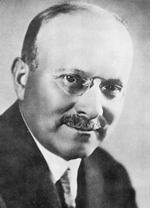 André Citroën, a visionary among automobile designers, established himself from the very beginning as a manufacturer who embraced innovation and was willing to take risks when he designed and built his automobiles. At the time when he set out to design and produce his first model, the Type A, the process of building and buying cars was very different from what it is today. Automobile manufacturers would only build the engine, drivetrain, and chassis. It was up to the consumer to contract with a coachworks, who would construct a body, fit the interior, and complete the finished vehicle.
André Citroën, a visionary among automobile designers, established himself from the very beginning as a manufacturer who embraced innovation and was willing to take risks when he designed and built his automobiles. At the time when he set out to design and produce his first model, the Type A, the process of building and buying cars was very different from what it is today. Automobile manufacturers would only build the engine, drivetrain, and chassis. It was up to the consumer to contract with a coachworks, who would construct a body, fit the interior, and complete the finished vehicle.